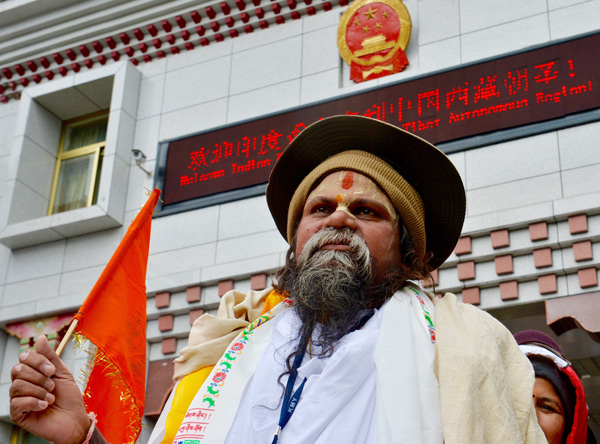Indian pilgrims step out on new Tibetan route
 |
|
Indian pilgrims reach the Nathu La Pass in Dromo county, Tibet, on Monday. China has opened a new path for Indian pilgrims to visit sacred religious sites in the autonomous region. Daqiong / China Daily |
Fifty people have started a 12-day journey using a new path that makes it easier for Indian pilgrims to visit sacred religious sites in the Tibet autonomous region.
The pilgrims are using the Nathu La Pass, which was officially opened in Dromo county, Tibet, on Monday.
Hindus regard Tibet’s Mount Kailash and Lake Manasarovar as holy religious sites, and pilgrims cross the border to pay homage at both between June and November.
The opening ceremony was held at the Nathu La Pass and was attended by officials from China and India along with the pilgrims.
Le Yucheng, China’s ambassador to India, Dong Mingjun, vice-chairman of the Tibet autonomous region, and Ashok K. Kantha, Indian ambassador to China, spoke at the ceremony.
China’s Tibet borders India, with both countries enjoying close relations over thousands of years as a result of frequent exchanges.
Dong said, “This event is a practical action in implementing the important consensus reached by leaders of the two countries, and an important measure in further deepening the traditional China-India friendship.”
He said authorities in Tibet would make improvements to the new pilgrimage path, to reception facilities and to medical aid to ensure pilgrims have safe and successful trips.
Le said, “Since President Xi Jinping announced the new route to Kailash and Manasarovar through the Nathu La Pass for Indian pilgrims in September, China and India have had close consultations.”
He said the new route is more comfortable, more convenient and much safer than older ones.
Le also said China has a good understanding of how Mount Kailash and Lake Manasarovar are regarded by Indian pilgrims and will do what it takes to make their journeys pleasant and memorable.
Kantha said, “The new pilgrimage route is another enduring symbol of the rich and growing people-to-people ties between India and China.”
Amarnath, a Hindu from Mumbai and one of the first 50 Indian pilgrims to use the new route, said: “I have waited for ... a long time to pay homage to Mount Kailash and Lake Manasarovar. My dream has finally come true, and I want to thank the Chinese government.”
At the ceremony, the pilgrims were presented with emergency supplies for the high plateau by the Chinese embassy in India.
China has welcomed 80,000 Indian pilgrims in the past decade, according to the Tibet autonomous region government.
daqiong@chinadaily.com.cn














